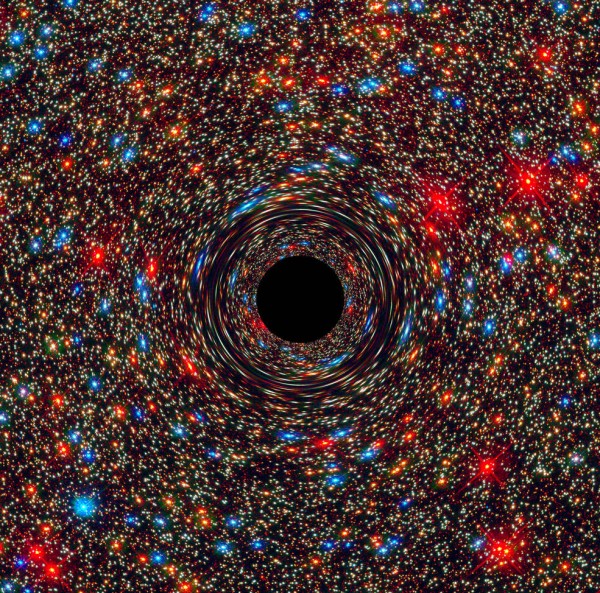Stephen Hawking: Escape from Black Holes is Possible with 'Soft Hair'
| Ana Verayo | | Jun 08, 2016 04:03 AM EDT |
(Photo : NASA, ESA, and D. Coe, J. Anderson, and R. van der Marel (STScI)) This computer-simulated image shows a supermassive black hole at the core of a galaxy. The black region in the center represents the black hole’s event horizon, where no light can escape the massive object’s gravitational grip. The black hole’s powerful gravity distorts space around it like a funhouse mirror. Light from background stars is stretched and smeared as the stars skim by the black hole.
Famed physicist Stephen Hawking reveals how not to give up when you get lost inside a black hole, stating in a new study that black holes have "soft hair" that can capture data and anything that gets sucked in or disappears into these mysterious, colossal cosmic objects.
Like Us on Facebook
Hawking first theorized in 1975 these "soft hairs", that in the event that a black hole evaporates, these hairs can release all the information that has been locked up inside. Just last year, Hawking and co-authors of the study, Malcolm Perry from the University of Cambridge and Andrew Strominger from Harvard University, announced how black holes are not just "eternal prisons" that were once thought, and apparently, objects can even escape and travel through another universe.
Hawking adds that this data cannot be stored inside the black hole's core but this can be found along its edges or boundaries, that are known as the event horizon, where not even light can escape.
In this new study, Hawking and team explains the mechanism behind these "soft hairs", or this halo pattern that emanates from the black hole's event horizon. As a charged particle passes through this threshold, it combs through this soft hair in a process known as supertranslation.
Some 50 years ago, physicist John Wheeler first theorized how black holes simply have no hair, which means that black holes do not possess any features and are only characterized by its mass, electric charge and angular momentum.
Hawking also first thought how black holes do not possess infinite lifetimes as they would eventually leak and explode into oblivion, radiating charged particles throughout the cosmos as the data in a dying black hole would then be erased.
In this new study, Hawking refutes his own theory and Wheeler's as well, and believes how even if particles are already falling into the endless black hole pit in what seems like eternity, data still gets retained at the edges of the black hole where these soft hairs catch these quantum particles.
Researchers have demonstrated in this new study that when a charged particle is falling into a black hole, this in turn "excites" these soft hairs. When a black hole evaporates, it conserves these new charges where the data about the hair on the event horizon is expected to emit from the Hawking radiation, according to the study, which can resolve the ongoing black hole information problem.
The team also says that they have no yet determined if all data are captured by the hairs and if all data can be transferred or just remnants of it. This new study is published in the journal, Physical Review Letters.
TagsStephen Hawking, Black Holes, data information black holes, soft hair black hole, possible escape exit from balck hole, physics, black hole information paradox
©2015 Chinatopix All rights reserved. Do not reproduce without permission
EDITOR'S PICKS
-

Did the Trump administration just announce plans for a trade war with ‘hostile’ China and Russia?
-

US Senate passes Taiwan travel bill slammed by China
-

As Yan Sihong’s family grieves, here are other Chinese students who went missing abroad. Some have never been found
-

Beijing blasts Western critics who ‘smear China’ with the term sharp power
-

China Envoy Seeks to Defuse Tensions With U.S. as a Trade War Brews
-

Singapore's Deputy PM Provides Bitcoin Vote of Confidence Amid China's Blanket Bans
-

China warns investors over risks in overseas virtual currency trading
-

Chinese government most trustworthy: survey
-

Kashima Antlers On Course For Back-To-Back Titles
MOST POPULAR
LATEST NEWS
Zhou Yongkang: China's Former Security Chief Sentenced to Life in Prison

China's former Chief of the Ministry of Public Security, Zhou Yongkang, has been given a life sentence after he was found guilty of abusing his office, bribery and deliberately ... Full Article
TRENDING STORY

China Pork Prices Expected to Stabilize As The Supplies Recover

Elephone P9000 Smartphone is now on Sale on Amazon India

There's a Big Chance Cliffhangers Won't Still Be Resolved When Grey's Anatomy Season 13 Returns

Supreme Court Ruled on Samsung vs Apple Dispute for Patent Infringement

Microsoft Surface Pro 5 Rumors and Release Date: What is the Latest?










